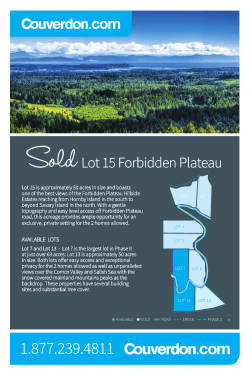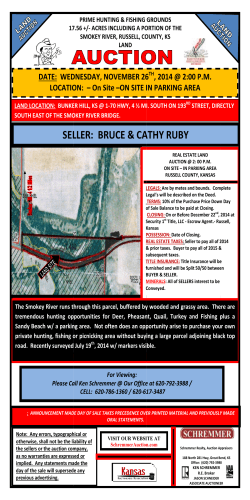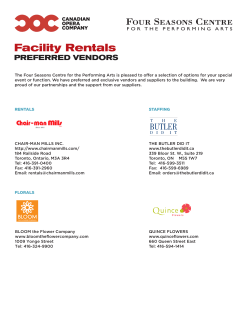
HARDANGERVIDDA
Hardangervidda The largest National Park in Norway 2° Hardangervi dda National Park Hardangervidda National Park 3° The largest highland plateau in Northern Europe Hardangervidda is a particularly valuable highland area and the largest national park in Norway. The area is important as the home of the largest wild reindeer herds in Europe and the largest sub¬populations of many species of birds that are comparatively rare in southern Norway. The plateau has a large diversity of plants in the boun¬dary area between western and eastern species (coastal and inland species). The thousands of lakes make the plateau an eldorado for hikers with tents and fishing rods. Evidence of how people have utilised the natural resources is prominent on Hardangervidda in the form of paths, tracks, shelters and transhumance summer dairy farms. The hunting and fishing resources are still actively used by people living in the surrounding area. A coffee break in Kvennadalen (KN) 4° Hardangervi dda National Park Spending the night on the plateau (KN) Straumdalen Hardangervidda National Park 5° A marvellous view over the endless Hardangervidda (KA) E XPE R IENCE NATU RE THE LANDSCAPE With a tent and a fishing rod From sea bed to highland plateau Hardangervidda is an eldorado for hikers with tents and fishing rods. The area is famous for its many lakes and rivers abounding in fine brown trout. There are numerous marked paths and a number of staffed lodges and self¬service huts. Hunting is permitted on Hardangervidda. Remember to have your fishing and hunting licences. Hardangervidda is a typical highland plateau with exten¬sive, undulating plains. Only in the west are the moun¬tains more dramatic. The hard bedrock in the south¬eastern part of the national park is the remnants of a more than 1 billion-year-old mountainous landscape. Skiing is popular (SR) The mountains were eroded and the sea inundated the low¬land plains. The calcareous bedrock in the north-western part of the area formed from sediments deposited on the sea bed 450-600 million years ago. These strata were later overridden by a continuous sheet of rock thrust from the west and both units were pressed together and folded. A new mountainous landscape had risen from the sea. Hårteigen and the mountains around the Hardanger¬jøkulen ice cap are monadnocks remaining from this mountain chain, which was otherwise eroded down to the basement rocks, particularly during the glacial period. 6° Hardangervi dda National Park Purple Saxifrage (NV) Hardangervidda National Park 7° Scandinavian primrose (NV) VE GE TATION Windy heaths The variations in bedrock and climate mean that the vegetation varies from western to eastern parts of the plateau. Plants grow more vigorously in the west where Rhizocarpon geographicum, a lichen (KN) there is more precipitation and a more even temperature. The eastern part is much less lush. Windy heaths are common in areas with little snow and poor bedrock. Hårteigen (NV) 10° Hardangervi dda National Park A wild reindeer herd on Hardangervidda (KN) Hardangervidda National Park 11° Stoat (KN) A NI MAL AND B IRD L IF E The largest wild reindeer herds in Europe Hardangervidda became ice free about 9000 years ago. Lichens began to grow on the bare ground, providing food for reindeer. Every spring, the large herds of wild reindeer migrate westwards from their winter grazing on the eastern part of the plateau to where high preci pitation and nutrient-rich soils provide good summer grazing with succulent grass for both reindeer and domestic livestock. Early in May, the pregnant females reach their calving grounds. Disturbing them then may prove disastrous. The males and juveniles migrate to lower ground and graze in the birch woods. r eindeer management is to stabilise the winter population to accommodate it to the grazing resources. The flat landscape with its numerous lakes and wetlands distinguishes Hardangervidda from other mountainous areas in southern Norway. This habitat forms the basis for a large and important population of many kinds of ducks and other wetland species. The breeding populations of black-throated divers, scaups, velvet scoters, common scoters, dot¬terels, Temminck’s stints, great snipes and shore larks are particularly valuable. The reindeer need to escape from mosquitoes and warble flies later in the summer, and several thousands may then gather on snowfields on higher ground. After the rutting period in autumn, the animals migrate east¬wards again to the windy lichen heaths. The availability of winter grazing limits the size of the reindeer stock on Hardangervidda. The objective of the wild Black-throated diver (KOJ) 12° Hardangervi dda National Park A reindeer hunter (SR) Hardangervidda National Park 13° An old house site (KN) H I S T O RY AND CU L TU R A LE HER ITA G E People and the plateau People probably came to Hardangervidda at the same time as the reindeer, after the last Ice Age. About 250 Stone Age sites have been found, the oldest dating from 6300 BC. The people probably led a nomadic life, follow¬ing the reindeer migration routes. Many of the sites are close to bottlenecks in the landscape, where migrating reindeer herds became compacted to cross lakes and rivers. The early hunters just used bows and arrows, but later they also drove the animals into traps and pitfalls. Botanists have shown that, at times during the Stone Age, Hardangervidda had woodland and scatte red trees as high as 1100 – 1200 m. Finds from excavations of Stone Age sites show that the people hunted reindeer and ptarmigan; elk and trout bones were also found. In our day too, the natural resources on Hardangervidda are very valuable for the surrounding settlements. Hardangervidda National Park differs from other Norwegian national parks because it has been used a great deal by local people, has many buildings and much privately owned land. Consequently, there is a conside¬rable amount of motorised traffic associated with the harvesting of resources, the upkeep of buildings and the running of lodges and huts for hikers and skiers. Large flocks of sheep are taken there to graze each summer, and for many people fishing and hunting are highly valued forms of relaxing recreation and sources of food. The old paths crossing the plateau were important routes linking southeast and west Norway. Nordmannsslepa, which links Veggli in Numedal with Eidfjord, with branches to Hol and Uvdal, is a particularly well-known path. Shelters used by hunters and fishermen, cattle pens and transhumance summer dairy farms scattered over the plateau take our minds back to the hard times when people had to utilise the resources on Hardanger¬vidda to survive. Riding on Hardangervidda (SR) 14° Hardangervi dda National Park Hardangervidda National Park 15° Hardangervidda National Park in brief Slettedalen in Tinn (SR) You are a guest of nature in a national park • You may go wherever you like, on foot or ski, but the basic rule is that anything with an engine is prohibited. • You can stop wherever you like and pitch a tent. Always tidy up after yourself and don’t leave litter. • You can light a fire, but remember the general ban on lighting fires in forests from 15 April to 15 September. Be considerate when collecting firewood. Where: Odda, Ullensvang, Eidfjord, Hol, Nore & Uvdal, Tinn and Vinje municipalities in Hordaland, Telemark and Buskerud counties. How to reach the Hardangervidda National Park: By train to Geilo, Ustaoset or Haugastøl. By coach or car on Route 7 across Hardangervidda; several convenient stops and branch roads to the national park. By car on Route 40 from Nore Uvdal to Geilo, several stopping places and branch roads to the national park. By car on Route 364 to Tinn Austbygd, branch off to Breisetdalen and park at Stegaros or Synken; boat across Mårvatnet from Synken to Mårbu. By car on Route 37 to Møsvatn and continue by boat to the lodge at Mogen. By coach or car on E 134 from Haukeli to Jøsendal, several stops and branch roads to the national park. By car from Jøsendal to Brimnes, several stops and branch roads to the national park. Information on overnight accommodation and services: Each municipality has a tourist information office. Destinasjon Eidfjord AS, Tel +47 53 67 34 00, www.visiteidfjord.no Huts: There are 7 staffed lodges and 5 self-service huts in the national park. Tips: There are good opportunities for long hikes, ski trips, hunting and fishing in the national park. • You can pick berries, mushrooms and common plants for your own use. Be considerate of cultural relics, vegetation and fauna. Be extra careful during the breeding and nesting season. Maps: Hardangervidda 1:100 000. Several 1:50 000 scale maps. • Make use of the hunting and fishing oppor tunities. Remember a hunting/fishing licence. Never use live fish as bait, or transfer live fish from one watercourse to another. Adjacent protected areas: Skaupsjøen/Hardangerjøkulen landskapsvernområde Møsvatn Austfjell landskapsvernområde Bjoreidalen naturreservat • You can take your dog with you, but remember to keep it on a lead. ISBN (Trykt) 978-82-8284-001-9 ISBN (pdf) 978-82-8284-002-6 Layout: Guri Jermstad AS. Photo: Nils Valland (NV), Sigve Reiso/ Naturarkivet.no (SR), Kim Abel/ Naturarkivet.no (KA), Knut Nylend (KN) og Karl-Otto Jacobsen (KOJ) Front cover: Kvennadalen (KN) and black/white: Hardangervidda (NV) Back cover: Fish (KN) Print: GRØSET™ Designated: 1981 Area: 3422 km2 National Park Centers: Hardangervidda Natursenter, Eidfjord, Tel +47 53 66 59 00, www.hardangervidda.org Norsk Villreinsenter sør, Skinnarbu, Tel +47 35 08 05 80, www.villrein.no Management and supervision: County Governor of Hordaland, County Governor of Buskerud and County Governor of Telemark, www.fylkesmannen.no Supervising Committee for Hardangervidda in Hordaland (Tel +47 53 67 15 00), in Buskerud (Tel +47 32 74 27 00) and in Telemark (Tel +47 35 08 11 70) Norwegian Nature Inspectorate at Rødberg (Tel +47 32 74 46 85) and Skinnarbu (Tel +47 35 08 12 51) More information: www.norgesnasjonalparker.no NORWAY’S NATIONAL PARKS Norwegian national parks – our common natural heritage National parks are designated to protect large areas of unspoilt countryside – from the sea to the mountaintops – for the sake of Nature herself, we ourselves and future generations. The national parks contain a wealth of splendid scenery and varied animal and plant life, waterfalls, glaciers, towering peaks, never-ending plateaus, deep forests, and beautiful fjords and coasts. Cultural heritage sites also show how the areas were used in bygone days. The national parks offer a vast range of thrilling and exciting natural history. Make use of the fantastic Norwegian countryside – on Nature’s own terms. Welcome to Norwegian national parks! www.dirnat.no/english
© Copyright 2025









